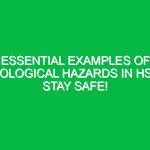Personal Protective Equipment (PPE) is a critical component in ensuring the health, safety, and environmental (HSE) well-being of individuals in various industries. The correct use of PPE can significantly mitigate risks associated with workplace hazards, thereby protecting workers from injuries and health issues. This article delves into essential examples of PPE within the HSE context, highlighting their importance, applications, and regulatory frameworks.
Understanding the Importance of PPE in HSE
PPE encompasses a wide range of protective gear designed to shield individuals from specific hazards that could cause injury or illness. These hazards may arise from physical, chemical, biological, or environmental threats. The relevance of PPE in the HSE domain cannot be overstated; it plays a vital role in preventing workplace accidents, thereby fostering a safer working environment.
In industries such as construction, healthcare, manufacturing, and chemical processing, employees are frequently exposed to various risks. Here, PPE serves as the last line of defense after administrative controls and engineering solutions have been employed. The effective use of PPE not only protects workers but also enhances productivity by reducing downtime due to injuries.
Common Examples of PPE in HSE
With a variety of PPE available, it’s essential to select the appropriate equipment based on specific workplace hazards. Below are some of the most common examples of PPE used in various industries:
1. Head Protection
- Hard Hats: Critical in construction and manufacturing environments, hard hats protect against falling objects and head injuries. They are designed to absorb the shock from impacts.
- Helmets: Used in specific industries such as mining and forestry, helmets often include additional features such as face shields and ear protection.
2. Eye and Face Protection
- Safety Glasses: Essential in environments where debris or chemicals may pose a risk to the eyes, safety glasses should meet specific ANSI standards.
- Face Shields: Used in conjunction with safety glasses or goggles, face shields provide additional protection against splashes and flying particles.
3. Respiratory Protection
- Respirators: Necessary in environments where airborne contaminants are present, respirators filter out harmful particles and gases. Types include N95 masks for particulate matter and full-face respirators for chemical exposure.
- Self-Contained Breathing Apparatus (SCBA): Used by firefighters and in hazardous waste operations, SCBAs provide breathable air in environments with oxygen deficiency or toxic atmospheres.
4. Hearing Protection
- Earmuffs: Ideal for environments with high noise levels, earmuffs help reduce the risk of hearing loss.
- Earplugs: Commonly used in various industries, earplugs offer a more discreet option for hearing protection and can be disposable or reusable.
5. Hand Protection
- Gloves: Different types of gloves protect against cuts, abrasions, chemicals, and temperature extremes. It is vital to choose gloves that are suitable for specific hazards.
- Cut-Resistant Gloves: Used in manufacturing and construction, these gloves reduce the risk of cuts and lacerations from sharp objects.
6. Foot Protection
- Safety Boots: Steel-toed or composite-toed boots protect against heavy falling objects and punctures. Slip-resistant soles are crucial in environments where slips and falls are a concern.
- Electrical Hazard Boots: Designed for electrical work, these boots protect against electrical shocks.
7. Body Protection
- Protective Clothing: Includes coveralls, lab coats, and aprons tailored to specific hazards such as chemicals, heat, and biological agents.
- High-Visibility Clothing: Essential for workers in construction and roadwork, high-visibility gear ensures that employees are seen by moving vehicles and machinery.
8. Fall Protection
- Safety Harnesses: Used in construction and maintenance work at heights, safety harnesses prevent falls and are often used in conjunction with lanyards and anchor points.
- Guardrails: Installed to prevent falls from elevated surfaces, guardrails are a critical safety feature in many workplaces.
Best Practices for PPE Use
While PPE is essential for safety, its effectiveness hinges on proper usage. Here are several best practices to enhance the efficacy of PPE:
- Training: Employees must be adequately trained on the correct use, maintenance, and limitations of PPE. Regular training sessions can reinforce safe practices.
- Fit Testing: For respiratory protection, conducting fit tests ensures that masks and respirators form a proper seal around the face, preventing contamination.
- Regular Inspections: PPE should be routinely inspected for wear and tear. Any damaged equipment should be replaced immediately to maintain safety standards.
- Accessibility: Ensure that PPE is readily available and easily accessible to all employees, promoting consistent usage.
- Feedback Loops: Encourage employees to provide feedback on the comfort and effectiveness of PPE, facilitating continuous improvement.
Regulations and Standards Governing PPE
Compliance with regulations and standards is vital for the effective implementation of PPE in the workplace. Various organizations set forth guidelines that dictate minimum requirements for PPE:
- Occupational Safety and Health Administration (OSHA): OSHA mandates that employers provide appropriate PPE and ensure its proper use to safeguard employee health and safety.
- American National Standards Institute (ANSI): ANSI sets standards for PPE to ensure consistency and safety in protective equipment.
- National Institute for Occupational Safety and Health (NIOSH): NIOSH certifies respirators and other safety equipment, ensuring they meet stringent safety standards.
Understanding these regulations helps employers implement effective safety programs and provides employees with the necessary protections against workplace hazards.
Real-Life Applications and Case Studies
To illustrate the importance of PPE, consider the case of an industrial construction site where a worker sustained a severe head injury due to a falling object. The investigation revealed that although hard hats were available, they were not being used consistently. This incident led to a comprehensive review of safety protocols, emphasizing the need for mandatory PPE training and enforcement. Following these changes, the site reported a significant decrease in head injuries, highlighting how proper PPE use can enhance worker safety.
Another example comes from the healthcare sector during the COVID-19 pandemic. Healthcare workers faced unprecedented risks, and the use of PPE like masks, face shields, and gowns became essential in preventing virus transmission. Hospitals that strictly enforced PPE protocols saw lower infection rates among staff, showcasing the critical role of PPE in protecting health professionals and, by extension, patients.
Conclusion
In conclusion, the role of Personal Protective Equipment (PPE) in promoting health, safety, and environmental sustainability cannot be overstated. By understanding and implementing relevant examples of PPE, employers can create safer workplaces and protect their most valuable asset—their employees. Adhering to regulations and best practices ensures that the protective gear is effective and suited to the specific hazards faced. As industries continue to evolve, so too should our approach to PPE, ensuring that it remains a top priority in safeguarding health and well-being in all work environments.
Encouraging a culture of safety, where employees feel empowered to use PPE and participate in safety protocols, is vital. The ongoing commitment to health and safety not only protects individuals but also contributes to the overall success and sustainability of organizations.


